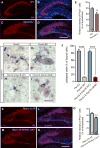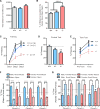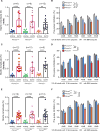PlexinA2 Forward Signaling through Rap1 GTPases Regulates Dentate Gyrus Development and Schizophrenia-like Behaviors
- PMID: 29320740
- PMCID: PMC5788190
- DOI: 10.1016/j.celrep.2017.12.044
PlexinA2 Forward Signaling through Rap1 GTPases Regulates Dentate Gyrus Development and Schizophrenia-like Behaviors
Abstract
Dentate gyrus (DG) development requires specification of granule cell (GC) progenitors in the hippocampal neuroepithelium, as well as their proliferation and migration into the primordial DG. We identify the Plexin family members Plxna2 and Plxna4 as important regulators of DG development. Distribution of immature GCs is regulated by Sema5A signaling through PlxnA2 and requires a functional PlxnA2 GTPase-activating protein (GAP) domain and Rap1 small GTPases. In adult Plxna2-/- but not Plxna2-GAP-deficient mice, the dentate GC layer is severely malformed, neurogenesis is compromised, and mossy fibers form aberrant synaptic boutons within CA3. Behavioral studies with Plxna2-/- mice revealed deficits in associative learning, sociability, and sensorimotor gating-traits commonly observed in neuropsychiatric disorder. Remarkably, while morphological defects are minimal in Plxna2-GAP-deficient brains, defects in fear memory and sensorimotor gating persist. Since allelic variants of human PLXNA2 and RAP1 associate with schizophrenia, our studies identify a biochemical pathway important for brain development and mental health.
Keywords: GAP; PlexinA2; Rap1; adult neurogenesis; dentate gyrus; fear memory; mossy fiber; schizophrenia; semaphoring; sensorimotor gating.
Copyright © 2017 The Author(s). Published by Elsevier Inc. All rights reserved.
Figures







Similar articles
-
Semaphorin 5A inhibits synaptogenesis in early postnatal- and adult-born hippocampal dentate granule cells.Elife. 2014 Oct 14;3:e04390. doi: 10.7554/eLife.04390. Elife. 2014. PMID: 25313870 Free PMC article.
-
Roles of semaphorin-6B and plexin-A2 in lamina-restricted projection of hippocampal mossy fibers.J Neurosci. 2010 May 19;30(20):7049-60. doi: 10.1523/JNEUROSCI.0073-10.2010. J Neurosci. 2010. PMID: 20484647 Free PMC article.
-
Bone morphogenetic protein signaling in the developing telencephalon controls formation of the hippocampal dentate gyrus and modifies fear-related behavior.J Neurosci. 2010 May 5;30(18):6291-301. doi: 10.1523/JNEUROSCI.0550-10.2010. J Neurosci. 2010. PMID: 20445055 Free PMC article.
-
[Roles of DISC1-interacting protein Girdin in postnatal development and adult neurogenesis in the dentate gyrus].Nihon Shinkei Seishin Yakurigaku Zasshi. 2011 Feb;31(1):23-8. Nihon Shinkei Seishin Yakurigaku Zasshi. 2011. PMID: 21409841 Review. Japanese.
-
Morphogenesis of the dentate gyrus: what we are learning from mouse mutants.Dev Neurosci. 2005 Mar-Aug;27(2-4):93-9. doi: 10.1159/000085980. Dev Neurosci. 2005. PMID: 16046842 Review.
Cited by
-
Molecular Basis of GABA Hypofunction in Adolescent Schizophrenia-Like Animals.Neural Plast. 2021 Apr 15;2021:9983438. doi: 10.1155/2021/9983438. eCollection 2021. Neural Plast. 2021. Retraction in: Neural Plast. 2024 Jan 24;2024:9780493. doi: 10.1155/2024/9780493. PMID: 33936193 Free PMC article. Retracted.
-
The phenotypic and transcriptomic effects of developmental exposure to nanomolar levels of estrone and bisphenol A in zebrafish.Sci Total Environ. 2021 Feb 25;757:143736. doi: 10.1016/j.scitotenv.2020.143736. Epub 2020 Nov 14. Sci Total Environ. 2021. PMID: 33243503 Free PMC article.
-
Precision medicine for psychotic disorders: objective assessment, risk prediction, and pharmacogenomics.Mol Psychiatry. 2024 May;29(5):1528-1549. doi: 10.1038/s41380-024-02433-8. Epub 2024 Feb 8. Mol Psychiatry. 2024. PMID: 38326562
-
Structure and function of Semaphorin-5A glycosaminoglycan interactions.Nat Commun. 2024 Mar 28;15(1):2723. doi: 10.1038/s41467-024-46725-7. Nat Commun. 2024. PMID: 38548715 Free PMC article.
-
Semaphorins in Adult Nervous System Plasticity and Disease.Front Synaptic Neurosci. 2021 May 11;13:672891. doi: 10.3389/fnsyn.2021.672891. eCollection 2021. Front Synaptic Neurosci. 2021. PMID: 34045951 Free PMC article. Review.
References
-
- Altman J, Bayer SA. Migration and distribution of two populations of hippocampal granule cell precursors during the perinatal and postnatal periods. J. Comp. Neurol. 1990;301:365–381. - PubMed
-
- Bagri A, Gurney T, He X, Zou YR, Littman DR, Tessier-Lavigne M, Pleasure SJ. The chemokine SDF1 regulates migration of dentate granule cells. Development. 2002;129:4249–4260. - PubMed
Publication types
MeSH terms
Substances
Grants and funding
LinkOut - more resources
Full Text Sources
Other Literature Sources
Medical
Molecular Biology Databases
Research Materials
Miscellaneous

